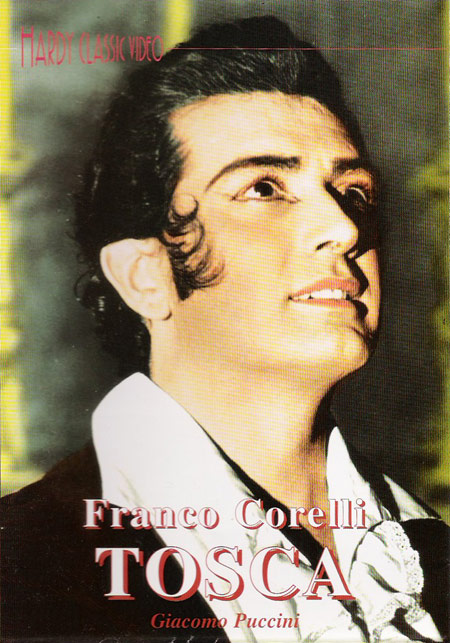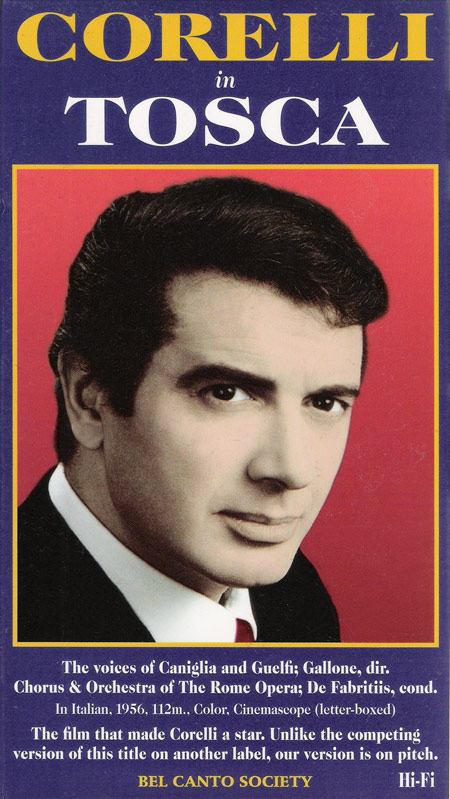Franco Corelli at Cinecittà
The 1956 color Tosca
|
Composer: Giacomo Puccini Performers: Cavaradossi Franco Corelli Orchestra, Chorus and ballet of the Opera di Roma Compared with: Bel Canto Society Video BCS-0540
Composer: Giacomo Puccini Performers: Cavaradossi Franco Corelli Orchestra, Chorus and ballet of the Opera di Roma
|
On and off pitchIn discussing this Hardy Classic DVD release of Franco Corelli's second filmed Tosca, one first has to consider the soundtrack's technical problems. As is generally known, there were always problems with the fluctuating pitch throughout the soundtrack recording. An easy point from which to check this is the change in vocal color in Corelli's 'Scarpia, bigotta satira', where the tenor sounds like a screaming cat (and this film is said to have earned him that nickname in Italy at the time of its issue). Hardy Classic, when asked by a friend of mine, made no secret of the fact that they failed to bring the DVD's soundtrack onto pitch. Their argument for leaving the problem untouched was that the cost of restoring things would have been too high if it was even technically possible with their print of this film, since the pitch problems in the audio are inseparable from the video. Also, they are not constant throughout, but occur at many different places, often in no more than a few bars at a time. Nevertheless, Bel Canto Society, in 1997, released their second version (as shown in the photobar next to this review) on video claiming that theirs was the only version on pitch. A close comparison of the Hardy Classic DVD with the Bel Canto Society video brought out a surprising result: the fluctuations in pitch are apparent in both versions. Yet Bel Canto Society rightfully claims to have issued the tape in the right pitch, which means that the Hardy Classic DVD version runs too fast throughout (in total a full five minutes shorter than the Bel Canto Society release). Therefore, the voices of all singers in the Hardy Classic DVD sound a little sharp, but Corelli's voice suffers the most, as his rapid vibrato is at times doubly exaggerated: from the quatertone upwards and from the even faster fluctuations in speed at the points where the speed suddenly increases. Not surprising then, that Corelli himself was utterly displeased when Hardy Classic first released this Tosca in the video era. Another problem is a leap in sound in Act II, where the DVD pressing appears to be faulty (although, at times, the video release suffers from this too). Altogether, despite a much less brilliant and substantially more dim sound, Bel Canto Society's video edition remains unchallenged when it comes to the sound. Picture qualityWhen taking a look at the picture quality there are some more surprising results: though Hardy Classic issued this Tosca with the expected razorsharp picture quality, they were unfortunate with the master for this DVD. Either the movie seems to be in duotone, or, if you want the colors, even the scenes in the cellar seem to be filmed in bright daylight! Though the competing Bel Canto Society video release offers no more than a washed out tape by todays standards, the colors on their product are full and warm. Still, for those who want to see the striking likeness between Franco Corelli and his brother (Ub)Aldo (Co)Relli (Sciarrone), the Hardy Classic DVD version is a must, as the picture quality of the Bel Canto Society video isn't good enough to bring this likeness to the fore. That also disqualifies Hardy Classic's earlier VHS release of this Tosca, which had a washed out print that was inferior to Bel Canto Society's second (letterboxed) and third (with narration) releases. Movie & actorsPerhaps 'performance' is a big word for a playback show in which most singing parts are dubbed by actors (in fact, next to the Corelli siblings only Sagrestano Vito De Taranto sings and acts his own part). Even so it is possible to act convincingly within the limits of the filming technique of those days, as the Otello movie with Mario del Monaco proves. Unfortunately, the experienced director Carmine Gallone didn't have a sure hand in picking his Tosca cast, either for the vocal or the acting parts. Next to Franco Corelli only the Sagrestano of Vito De Taranto manages to convince, but unfortunately he is a better actor than a singer. The same can be said when it comes to Ubaldo Corelli. Ubaldo had started singing more than a decade before his younger brother did, and by 1956 he was past his prime. In fact (perhaps due to the microphone placement) he can hardly be heard at all, which is a pity, since one is naturally curious to see if his voice has the same basic characteristics as the voice of his brother. When it comes to the lip-synching actors, Franca Duval's performance is perhaps the weakest link in this production. Her acting is stiff, her face inexpressive. Lacking heart and substance throughout, she utterly fails to convince, especially in 'Vissi d'arte'. This leaves us with a splendid Corelli, who convinces throughout, especially with his credible expressions of pain and anguish. Except for some moments when he seems to be at a loss with the placing of his hands, his movements are credible throughout, if one can accept that his acting is founded in theatre practice where one 'plays to the balconies', which at times leads to the exaggerations that opera singers were renowned for in those days (one can observe this also in Maria Callas' concert performances). The most balanced performance in this Tosca is perhaps Afro Poli's acting portrait of Scarpia, although the striking discrepancy between the vocal line created by Gian Giacomo Guelfi and Poli's horrible lip synchronization to it offers a fine example of the worst that can be experienced in this practice. Notwithstanding his credible performance, it remains a mystery why Poli, a great baritone himself, accepted the humiliating offer to mime the voice of the then still relatively unknown Gian Giacomo Guelfi. The same could be asked regarding Franca Duval, who was also an active soprano herself, though she never had a great career (although she did make some rare, but interesting 45RPM recordings). Perhaps she hoped for better luck at Cinecittà? When it comes to the set, the cardboard generic decor doesn't help in creating a convincing environment, nor does the dilletantesque camera direction – how one can film 'E lucevan le stelle' and focus on a streetlamp until the phrase 'disciogliea dai veli', instead of focussing on the tormented Cavaradossi is as inexplicable as unforgivable. Add the shaky camera movements and the sometimes rough editing and the result is a B to C category movie. |
THE SOUNDTRACK
Oliviero de Fabritiis is experienced enough to conduct a solid Tosca from the orchestral point of view. He also must be credited for balancing his vocal forces in the best possible way. Unfortunately his ensemble is not a memorable one, except for Franco Corelli's Cavaradossi and Gian Giacomo Guelfi's Scarpia. If one leaves out the soundtrack's pitch problems, Corelli gives a splendid, dramatic performance which fully reveals his true, lyric-dramatic vocation. Warm and tender in 'O dolci mani', heroic and ringing in 'Vittoria', mesmerizing in 'Recondita armonia' and engulfing in 'E lucevan le stelle'. Moreover, the way in which he handles 'disciogliea dai veli' already reveals the beginnings of the famous diminuendo he later would make at this point of the aria. And all this youthful ardor is answered by the elderly Maria Caniglia, who sings in a hopelessly old fashioned manner. It would be unfair to deny her great vocal skills. In fact she is in splendid voice, sounding more dramatic and involved than she ever did in any of the opera recordings with Beniamino Gigli, and this Tosca might well be her best studio recording. Still, her approach is clearly founded in the thirties and despite her superb technique the voice betrays her age: in Act I she sounds decidedly like Tosca's great grandmother. Pleading for Cavaradossi's life in Act II is not her thing either, though the dramatic outbursts are convincing. And she actually sings the third 'muori', after her body double Duval has stabbed Scarpia, instead of resorting to the usual low speak-scream. Her best moments are perhaps to be found in Act III, where she is truly convincing and, at times, even youthful. Credible throughout is Gian Giacomo Guelfi's Scarpia, which can be placed at the opposite spectrum of the more famous Scarpia of Tito Gobbi. Gobbi exploited Scarpia's evil through ruthless exaggeration, luring his soul into the realm of the devil himself, whereas Guelfi offers a portrait of a human being who is lost inside. In Guelfi's Scarpia it is precisely his power that has made him the slave of his own torment – indeed, torment, for this Scarpia makes you understand that even this brutal rapist was a child once, and that somewhere along the line something must have gone terribly wrong. In fact, this is exactly what the French revolution turned into: a vendetta against the past, especially against the powerlessness and the poverty of the former revolutionaries, who had suddenly gained absolute power.
A serious or good recording (see the Guerra e pace review elsewhere on this page) usually can be identified by quality singing in the minor parts. In this case, the support roles leave this Tosca crippled. Angelotti is as weakly sung as acted, Spoletta is a caricature and the vocal qualities of Sciarrone and Sagrestano have already been mentioned. Therefore, this DVD is one of those must-have curiosities for collectors of Franco Corelli, which is attractive first and foremost for the fact that it is in color and the fact that it shows his brother on the stage with him. For those more generally interested in opera, Corelli's black & white Tosca movie from the year before is much more interesting. Unfortunately , that one is not yet available on DVD, and its 1995 video release by Bel Canto Society (BCS –0660) is now out of print – RS.
***
For streaming sample clippings we refer you to the Filmography page.





